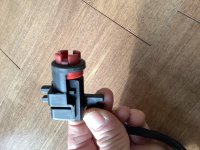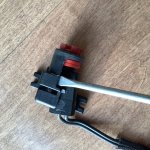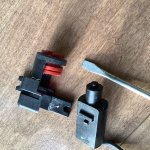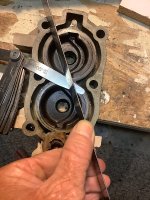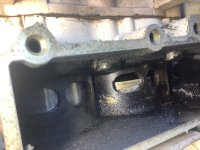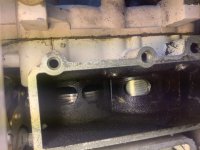UPDATE: Posted to encourage others who may have overheated their kicker. Just because your motor is now D.O.A., it might not be a death sentence. Resurrection can happen!
This motor got hot, really hot, but decking the head brought back compression, & you can see from the previous photos, the rings, bores, & pistons looked OK.
This motor appears to have had little use, the factory sticker was still on the carb, along with the pinstripes on the lower unit. I asked Racerone’s opinion, he thought it was worth saving, so I spent a few $.
I got the impeller, entire thermostat assembly, & the kill switch replaced.
Full Disclosure- I didn’t personally do any of that. I dropped it off at Racerone’s place, he has all the parts on hand, & knows how to do it.
Picked the motor up last week, tested it in a barrel, then put it in my 14’ Jon boat. There was black crap leaking out of the exhaust, I think the previous owner had used it a lot for trolling. I ran it full throttle for 1/2 hr, cleaned that mess out.
The one thing I did discover, & hadn’t noticed earlier was the twist throttle was wonky, 1st third of travel was fine, but then it seemed to bind.
I undid the throttle cable, & it was smooth, so that wasn’t the issue. Hooked it back up, then started looking closely at all the moving parts as it went to full throttle.
A-Ha. When the previous owner overheated it, it got hot enough to melt the pivot point of the THROTTLE ADVANCE LEVER,(#40 in the parts diagram).
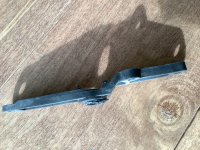
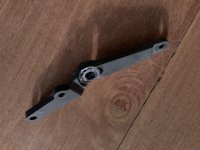
Instead of rotating as you twist the throttle, because the boss was melted, the lever “rolled” sideways, causing the twist grip to bind, & the throttle not to fully advance. I considered JB welding & trying to fix it because
this critical part is no longer in existence, not here, or Evinrude Canada. I scrounged one, installed, (this is where the factory manual was critical), EUREKA, full smooth throttle.
The other issue was the kill switch. The original was broken off at the little tabs that hold the lanyard.
Racer had one, but I was overseas, & he wasn’t sure I wanted to pay for it, so didn’t install it.
I took it, (cause his price was way less then what they list a new one for).
He explained about tying a line to the old one before you pulled the wires out, so you had a means to pull the new wires back through the sheath.
However, upon close observation of the replacement switch, (and being one who leans to the easiest way), these switches bear close resemblance to many automotive switches. There are a couple of small “tits” that actually hold the switch together.
Its actually two pieces that snap together. One part contains the little red buttons, but that’s all it does. The other part is the sealed unit, with a push button that actually makes the connection to ground out the ignition. Using a small flat head screwdriver, in the orientation shown, you can easily split the two pieces.
The RED “button” can then simply be pushed out, inserted into the original fitting, & the two parts snapped back together.
No fishing wires, or splicing if your working pull had the wires cut.
Obviously, this won’t work if the actual sealed switch is bad, but that’s easy to test with a multimeter. If it’s only the “red button”, this makes the job about 10 minutes. You only have to undo the 3 Phillips screws underneath the tiller handle, remove the cover plate, then 2 screws that hold the switch.
Ill make a separate post, with appropriate title, so it shows up when others search for Kill Switch Replace.
It starts 1 pull, pushed my 14’ Jon boat at full plane. I paid $100 for the motor, to use as parts for my other 8hp, but upon inspection/consultation, it seemed to good to part out.
